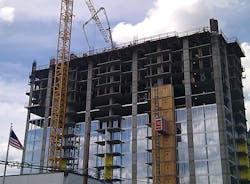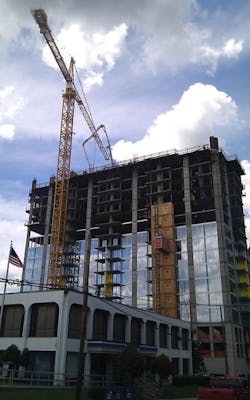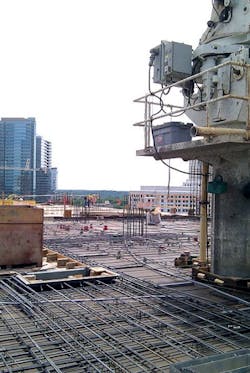High-Rise Towers Meet Increasing Demand for Multi-Family Housing
The economic downturn has made it challenging, if not downright impossible, for some Americans to secure a loan for a single-family home. As such, more tenants are migrating from the suburbs to urban areas, fueling a demand for high-rise, multi-family housing.
To meet the significant need for multi-family units, the Novare Group is currently building nine Skyhouse towers throughout the southeastern United States in Tampa and Orlando, Fla.; Atlanta; and Charlotte, Raleigh, and Durham, N.C. — with more projects on the horizon in Texas and other locations.
Batson-Cook, the general contractor, turned to Faith Technologies to install the electrical, fiber-optic/copper cabling, fire alarm, intercom/public address, lighting, and security systems for towers in Atlanta, Dallas, Houston, and, most recently, Austin, Texas.
For the Austin project, Faith Technologies secured a $5.6-million contract to wire and illuminate Skyhouse Austin, a 320-unit apartment tower. The team built the high-rise tower in a high-end section of downtown Austin with a vibrant art, music, and nightlife scene.
Faith Technologies, which has worked on multi-family projects for the last 25 years, brought many of its own employees in from Atlanta to help construct the residential tower. The electrical contractor has a dedicated field workforce that focuses on multi-family, high-production projects, many of whom helped provide electrical design and installation assistance.
“We have become part of the team for these projects, and we’re striving for a partnership on these projects due to their design-assist delivery nature,” says Chad Akin, vice president for Faith Technologies in Atlanta.
On the fast track
Like the other Skyhouse multi-family projects, Skyhouse Austin was built on a 12- to 14-month construction schedule, making it essential to build schedule efficiencies into the project, such as lean construction practices.
Akin says all of the buildings feature a similar design electrically and structurally, which creates a synergy among team members. By having the same experienced crews working on multiple projects, the project team can maximize efficiencies and control project costs.
To speed up construction on the job, the team also built a seven-story precast parking garage adjacent to the apartment tower rather than directly underneath it. That way, the construction team didn’t need to perform an elaborate amount of foundation work. In addition, the field workforce could hit the ground running when it came to the construction of the tower, says Jack Brock, vice president of preconstruction for Faith Technologies.
Another way the team was able to meet the deadlines on the fast-track project was by installing mechanical equipment on each floor rather than on the roof of the completed building.
“One of the most unique aspects of this job was the speed in which it needed to be completed,” says Brock. “The project needed to be turned over quickly, and mechanical systems typically have a long lag time. By putting the mechanical systems on each floor, it facilitated a faster buildout, because the field workforce didn’t need to wait for the entire structure to be completed or build the vertical pathways up to the roof before they could get the mechanical systems operational.”
The electrical and mechanical team installed the central systems up on the roof, but all the equipment that served the residential units was installed out on the balconies and concealed architecturally. As such, the team was able to pick up a lot of time in the schedule, explains Brock.
The electricians installed two 4,000A services to feed the residential tower and a 400A service for the parking garage. In addition, they put in a 600kW emergency diesel generator, 2 million ft of branch circuit wiring, and 200,000 ft of power distribution wiring.
Fostering teamwork and cooperation
Due to the tight construction schedule, the field workforce and project managers needed to work together as a team. To be profitable and meet project objectives, it was essential for all the major trades to be able to rely on one another, says Brock.
“On a traditional job, the trades all focus on their own specific scope of work and their coordination with one another,” he says. “On this project, we had to go out of our way to help each other succeed. Otherwise, the challenges one trade was experiencing would domino down the line, impacting the construction schedule and causing us all to fail.”
The demand for teamwork was especially important because the builder worked on a three-day concrete pour cycle. In other words, every three days, the workers poured an entire floor of the building, and all the trades, including the electrical team, had to keep up with this fast-paced schedule. It took about five months from the time the site was graded off to when the project was poured out, and then the interior buildout took another six to seven months.
“It was designed to go very fast, and was really a unique concept from the standpoint of design efficiencies and constructability,” says Brock.
Installing energy-efficient and environmentally friendly lighting
To illuminate the high-rise building, the electricians installed low-energy consuming luminaires, featuring LEDs and fluorescent lamps. The high-end architectural grade fixtures lit the apartment units, corridors, amenity areas, lobby, and other public spaces. LED lighting on the roof even changes colors so that the property owner can alter the color scheme of the atrium lighting during the holidays.
The team not only installed energy-efficient luminaires, but also took care to control lighting pollution and meet local standards. For example, the exterior fixtures lighting the parking garage and facade featured a full cut-off or shield design.
“Texas is very big on light pollution due to the large bird population,” says Akin. “We had to make sure that all the exterior lighting was indirect so the birds wouldn’t migrate to it. The lighting shields control the light pollution, and while you can see the light emitted, you can’t see the fixture.”
Skyhouse Austin, which opened its doors in December 2013, is now full of tenants looking to get away from the suburbs and enjoy the vitality of downtown Austin. Other projects are also underway in cities throughout the Southeast to allow Americans to live and work in urban areas.
“Multi-family is a strong market for us right now,” says Akin. “People are looking to live in downtown areas so they can be close to their work as well as to the local cultural scene in their cities.”
Fischbach is a freelance writer based in Overland Park, Kan. She can be reached at [email protected].
For additional photos and more project details, see the exclusive photo gallery.


